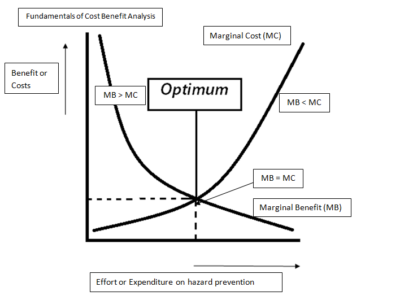Cost Benefit Analysis
Trump EPA Takes Aim at Cost Benefit Analysis; Misses
The proposed new EPA regulation on cost-benefit analysis seems to be a dud.
An EPA rule-making on cost-benefit analysis was supposed to be a big win for conservatives and industry. They want to rig cost-benefit analysis by counting all of a regulation’s costs but only some of the benefits. But the EPA proposal issued last week appears to give them only a token victory. The issue involves what are …
Continue reading “Trump EPA Takes Aim at Cost Benefit Analysis; Misses”
CONTINUE READINGReducing Coronavirus Fatalities: A Cost-Benefit Analysis
Q: From an economic perspective, what’s it worth spending to curb the pandemic? A: A lot.
At an extremely rough estimate, it would be worth spending about $4 trillion to cut the coronavirus death rate in half.
CONTINUE READINGLow-Hanging Fruit
A powerful metaphor can be illuminating, but it can also be highly misleading.
The idea of long-hanging fruit is ubiquitous in environmental policy — sometimes in the form of a simple metaphor, other times expressed in more sophisticated terms as an assumption of rising marginal costs of pollution reduction. It’s an arresting metaphor, and one that can often be illuminating. But like many powerful metaphors, it can also …
Continue reading “Low-Hanging Fruit”
CONTINUE READINGCost-Benefit Analysis and the Next President
If it’s Trump, we’ll see more of the same. But what if a Democrat wins?
Under executive orders dating back to Reagan, regulatory agencies like EPA are supposed to follow cost-benefit analysis in making decisions. Under the Trump Administration, however, cost-benefit analysis has barely even served as window-dressing for its deregulatory actions. It has launched a series of efforts to prevent full counting of regulatory benefits, as well as committing …
Continue reading “Cost-Benefit Analysis and the Next President”
CONTINUE READINGHow I Learned to Stop Worrying and Love OIRA
OIRA may have had its problems. What we have right now is much worse.
If you’re like most environmentalists, you probably don’t have a high opinion of OIRA, the White House office that’s supposed to oversee regulations. (For those who are new to this, OIRA stands for the Office of Information and Regulatory Affairs.) The complaints are legion: that OIRA lacks transparency, that it acts as a back door …
Continue reading “How I Learned to Stop Worrying and Love OIRA”
CONTINUE READINGSome Thoughts About “The Pursuit of Happiness”
What did the Declaration of Independence mean? And why does it matter?
When looking for something else, I stumbled on a Fourth of July post that I wrote a decade ago. Despite the temptation to rewrite, I’ve made a only a few small tweaks. It seems, if anything, more relevant today, when our society seems so divided about fundamental values and our President has devoted his life …
Continue reading “Some Thoughts About “The Pursuit of Happiness””
CONTINUE READINGGuest Blogger Nick Bryner: Cooking the Books While Cooking the Planet: A First Look at the EPA’s ACE Rule
Final Rule Changes Baseline Assumptions & Approach to Cost-Benefit Analysis in Attempt to Justify Weak Standards
Yesterday, the Trump EPA released its long-awaited response to the Obama-era Clean Power Plan. At first glance, the final rule has been carefully crafted in an attempt to avoid several glaring legal vulnerabilities of the rule—and to obscure the obvious inadequacy of the Administration’s response to climate change. The EPA has found many contradictory ways …
CONTINUE READINGEPA’s Magic Disappearance Trick
The Trump EPA has come up with a way to hide hundreds of deaths in plain view.
According to press reports, EPA is preparing to ignore possible deaths caused by concentrations of pollutants occurring below the national ambient air quality standards (NAAQS). This is a key issue in a lot of decisions about pollution reduction. For instance, there is no NAAQS for mercury, but pollution controls on mercury would, as a side …
Continue reading “EPA’s Magic Disappearance Trick”
CONTINUE READINGUnanswered Questions About Cost-Benefit Analysis
We have only fragmentary evidnece about how CBA actually functions in government decision-making.
Considering that people have been debating cost-benefit analysis at least since Reagan mandated its use in 1981, you would think we would have the answers to some basic questions about how it works. Yet we have very fragmentary information, generally based on the perspevtives of people at the agencies or in the White House Office …
Continue reading “Unanswered Questions About Cost-Benefit Analysis”
CONTINUE READINGEconomists vs. Environmentalists: Time for Deténte?
You don’t have to love economics to see it as a possible ally.
Cost-benefit analysis has long been the target of environmentalist ire. But one lesson of the Trump years has been that economic analysis can be a source of support for environmental policy — it is the anti-regulatory forces who have to fudge the numbers to justify their actions. Most energy and environmental economists are aghast at …
Continue reading “Economists vs. Environmentalists: Time for Deténte?”
CONTINUE READING







